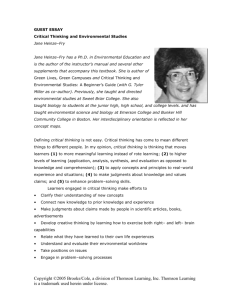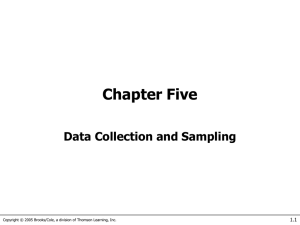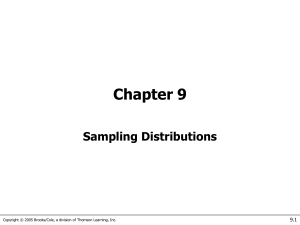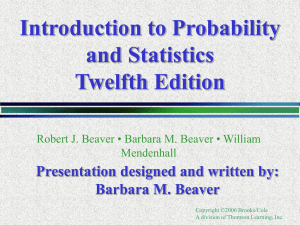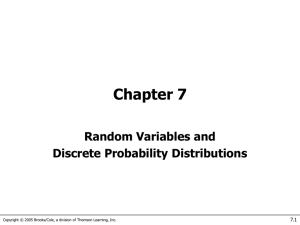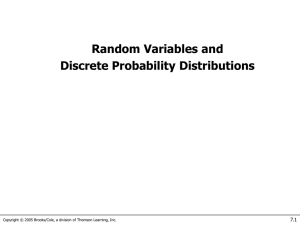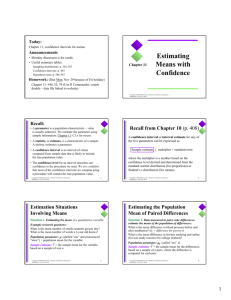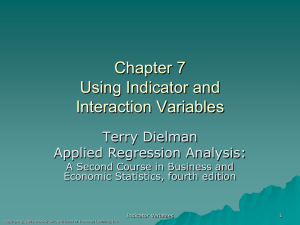Lecture Ch 3
advertisement
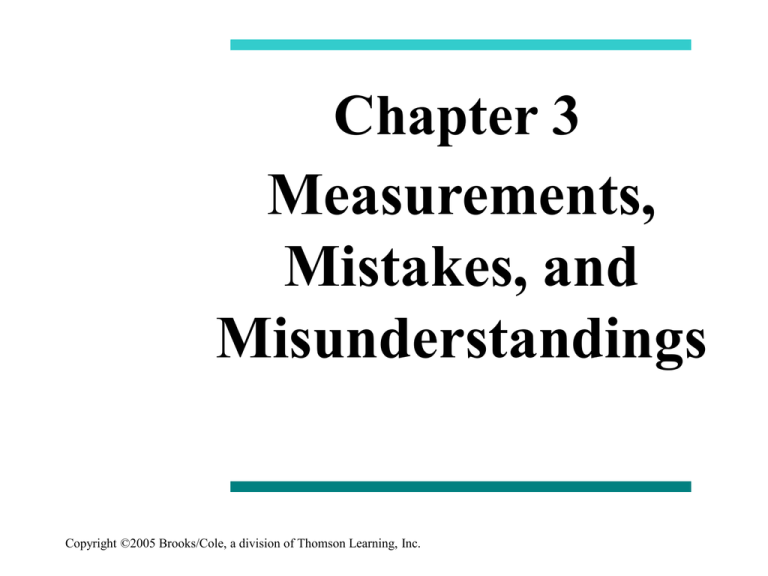
Chapter 3 Measurements, Mistakes, and Misunderstandings Copyright ©2005 Brooks/Cole, a division of Thomson Learning, Inc. Thought Question 1 (Deliberate Bias) Newsletter distributed by politician to his constituents gave results of nationwide survey on Americans’ attitudes about educational issues. One question: “Should your legislature adopt a policy to assist children in failing schools to opt out of that school and attend an alternative school—public, private, or parochial—of the parents’ choosing?” From wording of question, can you speculate on what answer was desired? Explain. Copyright ©2005 Brooks/Cole, a division of Thomson Learning, Inc. 2 It’s All in the Wording Simple changes of words can lead to big changes in answers. Example 1: How Fast Were They Going? Students asked questions after shown film of car accident. • About how fast were the cars going when they contacted each other? Average response = 31.8 mph • About how fast were the cars going when they collided with each other? Average response = 40.8 mph Copyright ©2005 Brooks/Cole, a division of Thomson Learning, Inc. 3 Problems with Survey Questions 1. 2. 3. 4. 5. 6. 7. Deliberate bias Unintentional bias Desire to please Asking the Uninformed Unnecessary Complexity Ordering of Questions Confidentiality and Anonymity Copyright ©2005 Brooks/Cole, a division of Thomson Learning, Inc. 4 Deliberate Bias Questions can be deliberately worded to support a certain cause. Example: • If you found a wallet with $100 in it on the street, would you keep it? • If you found a wallet with $100 in it on the street, would you do the honest thing and return it to the person or would you keep it? Appropriate wording should not indicate a desired answer. Copyright ©2005 Brooks/Cole, a division of Thomson Learning, Inc. 5 Unintentional Bias Questions are worded such that the meaning is misinterpreted by many. Example: • Do you use drugs? --- need to specify if you mean prescription drugs, illegal drugs, etc. • What is the most important date in your life? --need to specify if you mean calendar date or social engagement. Wording should be tested on a small group before the survey is finalized. Ask this group to “thinkaloud” when answering the question. Copyright ©2005 Brooks/Cole, a division of Thomson Learning, Inc. 6 Desire to Please Most respondents have a desire to please the person who is asking the question. People tend to understate responses about undesirable social habits, and vice versa. Example: Estimate of prevalence of cigarette smoking based on surveys do not match those based on cigarette sales. Copyright ©2005 Brooks/Cole, a division of Thomson Learning, Inc. 7 Asking the Uninformed People do not like to admit they don’t know what you are talking about. “When the American Jewish Committee studied Americans’ attitudes toward various ethnic groups, almost 30% of the respondents had an opinion about the fictional Wisians, rating them in social standing above a half-dozen other real groups, including Mexicans, Vietnamese and African blacks.” *Ask first questions that will allow you to understand if the person is informed on the issue… instead of asking people if they vote ask them where they vote. Copyright ©2005 Brooks/Cole, a division of Thomson Learning, Inc. 8 Unnecessary Complexity If questions are to be understood, they must be kept simple. Examples: • Too confusing: “Shouldn’t former drug dealers not be allowed to work in hospitals after they are released from prison?” • Asking more than one question at once: “Do you support the president’s health care plan because it would ensure that all Americans receive health coverage?” Copyright ©2005 Brooks/Cole, a division of Thomson Learning, Inc. 9 Ordering of Questions The order in which questions are presented can change the results. Example: 1. To what extent do you think teenagers today worry about peer pressure related to drinking alcohol? 2. Name the top five pressures you think face teenagers today. Likely that respondents will name peer pressure related to drinking alcohol as one of the 5 choices. Copyright ©2005 Brooks/Cole, a division of Thomson Learning, Inc. 10 Confidentiality and Anonymity People answer differently based on degree to which they are anonymous. • Confidentiality: researcher promises not to release identifying information about respondents. • Anonymity: researcher doesn’t know identity of respondents. Surveys on issues like sexual behavior and income are hard to conduct accurately. Copyright ©2005 Brooks/Cole, a division of Thomson Learning, Inc. 11 Thought Question 2 (Open vs. closed questions) Want to find out what people felt to be the most important problem facing society today. Better to give a fixed set of choices from which they must choose or an open-ended question that allowed them to specify whatever they wished? What would be the advantages and disadvantages of each approach? Copyright ©2005 Brooks/Cole, a division of Thomson Learning, Inc. 12 Open or Closed Questions: Should Choices Be Given? • Open question: respondents allowed to answer in own words. • Closed question: respondents given list of alternatives from which to choose answer. Often an ‘other’ choice is provided. Problem: May not include the answer that the respondent would have given if the question was open-ended Advantage: Easier to analyze and may provide answers that the respondent would not have otherwise thought of Solution: Give a set of open-ended questions to a test sample first and use their responses to create the list from which the respondents will have to choose from Copyright ©2005 Brooks/Cole, a division of Thomson Learning, Inc. 13 Thought Question 3 (Define what is measured) You and a friend are each doing a survey to see if there is a relationship between height and happiness. Without discussing in advance, you both attempt to measure the height and happiness of the same 100 people. More likely to agree on measurement of height or on measurement of happiness? Explain, discussing how you would measure each characteristic. Copyright ©2005 Brooks/Cole, a division of Thomson Learning, Inc. 14 Defining What is Being Measured • Important to be specific on how the variable of interest is being measured. • Different measurement techniques can lead to different conclusions. • Some non-quantitative variables can be hard to define. Copyright ©2005 Brooks/Cole, a division of Thomson Learning, Inc. 15 Some Concepts Are Hard to Define Precisely Example 4: Stress in Kids News Story 13: “How much stress is there in your life? Think of a scale between 0 and 10, where 0 means you usually have no stress at all and 10 means you usually have a very great deal of stress, which number would you pick to indicate how much stress there is in your life? (p. 40).” Results: Low stress (0 to 3) = 29% Moderate stress (4 to 6) = 45% High stress (7 to 10) = 26% Copyright ©2005 Brooks/Cole, a division of Thomson Learning, Inc. 16 Measuring Attitudes and Emotions How to measure self esteem or happiness? Common Method: respondents read statements and determine extent to which they agree with statement. Example for happiness: “I generally feel optimistic when I get up in the morning.” Indicate level of agreement from: ‘strongly disagree’ to ‘strongly agree’. Copyright ©2005 Brooks/Cole, a division of Thomson Learning, Inc. 17 Thought Question 4 (Measurement Reliability) At a swimming pool with a friend and become curious about the width of the pool. Friend has 12-inch ruler, with which he sets about measuring the width. He reports that the width is 15.771 feet. (.771 ft = 9 ¼ inches) If you or the friend were to measure the pool again would you get the same answer? Copyright ©2005 Brooks/Cole, a division of Thomson Learning, Inc. 18 Thought Question 5 (Measurement Validity) If you were to have your intelligence, or IQ, measured twice using a standard IQ test, do you think it would be exactly the same both times? Is this actually measuring your intelligence? Copyright ©2005 Brooks/Cole, a division of Thomson Learning, Inc. 19 Validity, Reliability and Bias Valid Measurement: actually measures what it claims to measure. Example = IQ test not a valid measure of happiness. Key = need to know exactly what was measured. Reliable Measurement: will give you or anyone else approximately the same result time after time, when taken on the same object or individual. Example = physical measurements with precise instrument. Key = watch for degree of precision being reported. Biased Measurement: systematically off the mark in the same direction. Example = time on clock that’s fast Copyright ©2005 Brooks/Cole, a division of Thomson Learning, Inc. 20 Defining a Common Language Categorical versus Measurement Variables Categorical Variables: those you can place into a category. Categorical variables whose categories have a natural ordering are called ordinal, while categorical variables whose categories do not have a natural ordering are called nominal. Measurement Variables: those for which we can record a numerical value and then order respondents according to those values -- also called quantitative variables. Measurement variables for which we could actually count the number of responses are called discrete, while measurement variables that can take on any numerical value are called continuous. Copyright ©2005 Brooks/Cole, a division of Thomson Learning, Inc. 21 Variability across Measurements Variability: used when we talk about 2 or more measurements in relation to each other. Measurement Error: amount by which each measurement differs from the true value. Natural Variability: results from changes across time in the individual or system being measured. Copyright ©2005 Brooks/Cole, a division of Thomson Learning, Inc. 22 The Importance of Natural Variability Three Reasons Variability Occurs … 1. Measurement error: measurements are imprecise. 2. Natural variability across individuals at any given time. 3. Natural variability in a characteristic of the same individual across time. Heart of Modern Statistics: Sorting through the natural variability to find the variability induced only by the different treatments. • If there were no variability within two groups, it would be easy to detect differences between the two groups. • The more variability there is within each group, the more difficult it is to detect differences between groups. Copyright ©2005 Brooks/Cole, a division of Thomson Learning, Inc. 23

